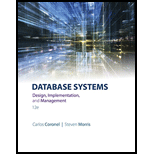
Concept explainers
Pessimistic locking:
It is one of the locking methods in concurrency control. The lock exists in the transaction until the transaction gets committed or rolled back.
Two-phase locking protocol:
It defined the serializability of the transaction but not prevent deadlocks. The process of locking and unlocking can be done using two phases in this protocol. They are: Growing phase and shrinking phase.
Growing phase:
New lock can be occurred on the transaction without unlocking the data items. The data items are locked in this phase.
Shrinking phase:
This phase used to release all transaction but not provide new lock on the transaction.
Row-level lock granularity:
This row-level locking process used to lock the single row in the table. It is used to improve the availability of data and involving in transaction conflict.
Trending nowThis is a popular solution!

Chapter 10 Solutions
Database Systems: Design, Implementation, & Management
- When the application of an optimistic approach to concurrency control is implemented, it is frequently observed that transactions experience prolonged durations for completion. Explain?arrow_forwardDescribe the phenomena of phantoms. Why, despite the usage of the two-phase locking scheme, might this occurrence result in improper concurrent execution?arrow_forwardExplain the concept of conflict-avoidance and its application in concurrency control, with reference to techniques like Strict Two-Phase Locking and Serializable Snapshot Isolation.arrow_forward
- Suppose the deferred modification technique is used in a database.a. Is the old value part of an update log record required any more?Why or why not? b. If old values are not stored in update log records, transaction undo isclearly not feasible. How would the redo phase of recovery have to bemodified as a result?c. Deferred modification can be implemented by keeping updated dataitems in local memory of transactions and reading data items that havenot been updated directly from the database buffer. Suggest how to efficientlyimplement a data item read, ensuring that a transaction sees itsown updates.d. What problem would arise with the above technique if transactions performa large number of updates?arrow_forwardIn a database transaction, the two main operations are READ and WRITE operations. So, there is a need to manage these two operations in the concurrent execution of the transactions as if these operations are not performed in an interleaved manner, and the data may become inconsistent. Consider the following scheduled transactions T1, T2, T3, and T4. T1 T2 T3 T4 Reads(X) Writes(X) Reads(Y) Writes(Y) Commit Reads(X) Time Reads(X) Writes(X) Reads(Y) Rollback Writes(Y) Writes(X) Commit • Identify all pair of transactions based on the occurred problem between two transactions (specify pairs, e.g., T1 => T2; T3=> T2; T3 =>T4; etc.). • Specify the name of a problem for each detected pair of transactions. • Justify the occurred problem for each pair of transactions.arrow_forwardIn the 2PL algorithm we considered, a transaction can't start until it has acquired all the locks it needs (we call this, Conservative 2PL). There is a different scheme possible, where a transaction does NOT need to wait for all its locks - it can start its transactions before all the locks have been acquired. What would be good about such a scheme, and, what would be bad? Do feel free to illustrate with a diagram.arrow_forward
- Consider a multi-granularity locking system, with lock modes S, X, IS, IX, and SIX as in lecture and database-level, file-level, page-level and record-level locking as shown in the following figure. Provide the sequence of lock requests required to perform the following transactions and write necessary complete Lock and Unlock operations in their correct order. T3 want to read all pages in F1 and modify about 10 pages, which can be identified only after reading F1.(MY ANSWER) Lock-SIX(DB); Lock-S(F1); Lock-X(P1); Lock-X(P1000); Unlock(P1000); Unlock(P1); Unlock(F1); Unlock(DB); is it corect? ………………………………………………………………………………………arrow_forwardWhat exactly is deadlock? What can be done to avoid it? When it occurs, how can it be resolved?arrow_forwardWe are given the following transaction schedule, where A,B,C are the addresses of the records in the database and T1 and T2 are the transactions. T1 R(A) W(A) R(B) W(B) R(C) W(C) COMMIT T2 R(C) R(B) W(B) a) Show that using strict two-phase locking leads to complications b) For example a, draw a »waits-for<< graph c) Resolve the problems in example a, using the "Wound-Wait" protocol R(A) W(A) W(C) COMMITarrow_forward
- Explain the concept of serializability in the context of concurrency control. How is it different from other forms of consistency, such as linearizability or strict two-phase locking?arrow_forwardA trigger's execution might result in the execution of another action. The depth of nesting in most database systems has a limit. Explain why they would put such a restriction in place.arrow_forwardProvide a high-level intuition for why log records for transactions on the undo-list must be processed in reverse order, whereas redo is performed in a forward direction. What can go wrong if the undo-list is processed in a forward direction or redo is performed in a backward order?arrow_forward
 Database Systems: Design, Implementation, & Manag...Computer ScienceISBN:9781305627482Author:Carlos Coronel, Steven MorrisPublisher:Cengage Learning
Database Systems: Design, Implementation, & Manag...Computer ScienceISBN:9781305627482Author:Carlos Coronel, Steven MorrisPublisher:Cengage Learning Database Systems: Design, Implementation, & Manag...Computer ScienceISBN:9781285196145Author:Steven, Steven Morris, Carlos Coronel, Carlos, Coronel, Carlos; Morris, Carlos Coronel and Steven Morris, Carlos Coronel; Steven Morris, Steven Morris; Carlos CoronelPublisher:Cengage Learning
Database Systems: Design, Implementation, & Manag...Computer ScienceISBN:9781285196145Author:Steven, Steven Morris, Carlos Coronel, Carlos, Coronel, Carlos; Morris, Carlos Coronel and Steven Morris, Carlos Coronel; Steven Morris, Steven Morris; Carlos CoronelPublisher:Cengage Learning

